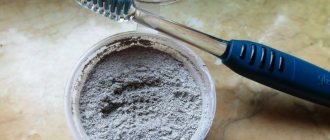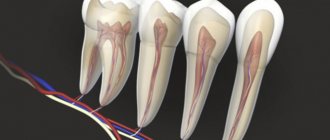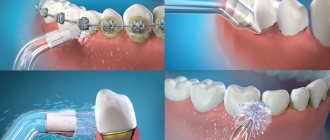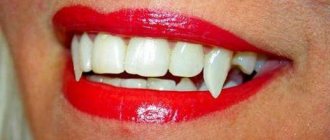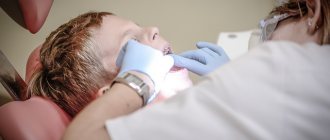Flux is a disease in which inflammation develops in the tissues surrounding the tooth, and an abscess develops on the periosteum. Severe pain appears, the gums become inflamed and swollen. Sometimes the swelling spreads to the cheek and chin. Flux develops in two stages: first, a focus of inflammation is formed, then an abscess appears. The disease can progress due to improper treatment or lack thereof. A throbbing pain appears, spreading to the ear, jaw, and temple.
The best option is to consult a doctor at the first symptoms, he will prescribe antibiotics and anti-inflammatory drugs, and, if necessary, remove the pus. But there are situations when it is not possible to receive qualified medical care; in these cases, you can try to cure the flux or at least slow down the pathological process at home.
How to quickly and effectively remove flux and its consequences at home? Complex treatment, including rinses, compresses, use of ointments and tablets.
Rinse
To rinse the gums during gumboil, decoctions of anti-inflammatory herbs, saline and alkaline solutions, and antiseptic pharmaceutical preparations are used.
The basis for any rinse is a solution of salt and baking soda (1 teaspoon per 2 glasses of water). Rinsing should be done once every half hour. This will eliminate swelling and inflammation and reduce toothache.
Rinsing can be done with ready-made preparations sold in pharmacies: Miramistin, Chlorgeskidine, Iodinol, Hexoral, Furacilin. All of them have antiseptic and anti-inflammatory effects and are available without a prescription. The procedure must be repeated several times a day, keeping the solution in the mouth for about a minute. It is not recommended to use these drugs to treat flux in children, as there is a risk of ingestion.
Of the herbal remedies, sage decoction is considered the most effective. It can be mixed in half with a decoction of chamomile, calendula, mustard grass, oak bark or St. John's wort. Gargling with decoctions should be done as often as possible, up to 10 times a day. You can also mix sage herb with regular green tea, add ¼ teaspoon of table salt and pour a liter of boiling water over this mixture. Important: rinse with warm liquid, but not hot or cold.
When you can't do without antimicrobials
Dentists prescribe antimicrobial agents if:
- inflammation is caused by streptococcal or staphylococcal infection;
- soft tissues in different parts of the oral cavity are infected;
- purulent complications should be urgently prevented or eliminated;
- inflammation progresses despite treatment;
- The patient came to the dental clinic with advanced disease.
Since there is not always time to identify the causative agent of the disease, doctors usually select broad-spectrum antibacterial drugs. They quickly cope with negative symptoms.
Compresses
If the inflammation process is started, the tumor spreads to the tissue surrounding the tooth. A problem arises: how to remove the manifestations of gumboil on the chin and cheek? In this case, compresses will be effective. It is important that the compress is cold. Hot, although it will temporarily relieve pain, will intensify the inflammatory process, since bacteria multiply much faster in a warm place. As a result, the volume of pus will increase, and the pain will only intensify. To remove such an abscess, surgery will be required.
To make a compress, you can use the solution left over from rinsing. You need to moisten gauze or bandage and apply it to the sore spot. To enhance the therapeutic effect, you can pour a spoonful of baking soda inside the compress and place it between the gum and cheek for several hours (you can stay overnight).
The healing properties of cabbage leaves have long been known in folk medicine. It needs to be boiled for about two minutes, cooled and applied to the cheek from the outside or inside. Onions are another antiseptic widely used for inflammation. You need to squeeze the juice out of it, moisten a tampon in it and apply it to the affected area. Egg yolk mixed with vegetable oil and sugar is also used for the compress.
At home, first aid for flux can be applying an ice cube to the inflamed area - the method is simple and effective, cold quickly relieves swelling and reduces pain.
Why does pathology develop?
The development of a purulent-inflammatory process is provoked by bacteria that penetrate the tissue before the extraction procedure (i.e., tooth extraction), during or after it. Let's look at each scenario in more detail.
Advanced dental diseases before the extraction procedure
It often happens that the patient already had gumboil, his tooth was removed, but the tumor remained. That is, initially a person came to dentistry with an acute or chronic inflammatory process that arose against the background of advanced caries, pulpitis or periodontitis. Doctors carried out extraction, antiseptic treatment of the hole and its curettage (cleaning), opened the abscess, and prescribed antibiotics. And if the patient does everything correctly, in accordance with the recommendations, then the flux gradually goes away, but this does not happen instantly, because the inflammation has been present in the tissues for a long time.
If, after pulling out a tooth, you ignore medical recommendations, then the gumboil does not go away or even becomes larger.
2. Unprofessional actions of the doctor during extraction
If flux appears after tooth extraction, this may be due to a violation of asepsis during the surgical operation. The specialist could have carried out poor quality sanitation of the hole and introduced an infection inside. The problem can be caused by the presence of fragments or remnants of roots, filling material, or instrument fragments in the tissues.
Important! To avoid the formation of cheek flux after tooth extraction and other complications, it is necessary to monitor the work of a doctor. At the final stage of the surgical operation, professional dental surgeons must take an x-ray (especially if the extraction procedure was complex and it was necessary to use a bur, extracting the root in parts). An X-ray examination allows you to check whether there are any fragments left in the socket that can cause inflammation. For more information about whether you need to take an x-ray after extraction, read the feature article on the website.
Failure to comply with recommendations during the rehabilitation period
Flux is one of the common complications that arise due to neglect of the following recommendations in the first 2–4 days:
- active chewing of food on the side of the jaw where the intervention took place, eating irritating foods (hard, hot, spicy),
- direct impact on a socket that has not yet healed: active rinsing, damage with a brush, tongue, finger, or foreign objects. As a result, a protective clot disappears from the wound, which prevents bacteria from penetrating inside,
- drinking alcohol and smoking,
- refusal to take medications and antibiotics prescribed by a dentist,
- applying warm compresses, warming the cheeks, visiting the sauna and steam room, physical activity, long stays in the open sun,
- complete lack of oral hygiene.
Ointments and gels
You can get rid of the symptoms of flux for a while using pharmaceutical ointments. They promote rapid healing of damaged gum tissue and eliminate inflammation.
Vishnevsky ointment stops the formation of pus and cleanses the tissues of it. Thanks to the presence of castor oil and birch tar in its composition, pain is reduced and the development of bacteria stops. This ointment should be used either at the onset of the disease or after rupture of the purulent sac. The drug is applied to a bandage or cotton swab and applied to the sore spot for several hours.
Levomekol quickly restores tissue and destroys bacteria. The drug is effective at any stage of flux, even when pus is released. The ointment should be used 3 times a day and kept on the affected area for about 3 hours. Metrogyl denta gel is carefully rubbed into the inflamed area, after preliminary drying with a cotton swab. Acts quickly, cooling and relieving pain. Apply three times a day.
Traditional medicine suggests using molten propolis mixed with hot sunflower oil as an ointment. The result is a thick, aromatic ointment that should be applied directly to the gums. Another recipe is based on making a tincture of calamus root and propolis. This liquid must be kept in the mouth for about two minutes. To ensure that the tincture is not so hot and unpleasant to the taste, you need to leave the vessel open for a while.
What types of pathology are there?
Doctors distinguish two types of disease - acute and chronic. After extraction, an acute form usually occurs, accompanied by severe symptoms, sudden appearance and rapid development. The chronic type of the disease is sluggish; the patient may not be aware of its existence for six months or even several years, until the pathology worsens due to decreased immunity or other provoking factors (hypothermia, stress, physical and emotional overload).
Pills
Treatment with medications at home includes taking anti-inflammatory and painkillers. Some of them also have antipyretic effects. You can’t prescribe antibiotics yourself; you can only make the situation worse.
The following drugs can be used for treatment:
- Nimesil - painkillers that eliminate the inflammatory process at any stage of the disease. You need to take them 1 piece 2 times a day. The duration of treatment is determined by the severity of symptoms.
- Diazolin - antiallergic tablets. They help eliminate swelling, relieve inflammation, and reduce the purulent sac. Depending on the amount of tissue swelling, you need to take from 1 to 3 tablets per day.
- Diclofenac is an anti-inflammatory tablet that reduces swelling and relieves pain. It is recommended to take 22–50 mg 2 times a day.
How can you quickly remove flux at home? Unfortunately, you won’t be able to recover completely on your own. All the drugs described only temporarily relieve the symptoms of the disease. Home treatment is an ambulance for flux, but not a way to get rid of it forever.
project-n.ru
Features of periostitis in children
Flux after tooth extraction in a child is a rather rare phenomenon, since the milk units have short roots, their extraction takes place without unnecessary trauma and difficulties, and after the operation a small and shallow wound remains, which heals very quickly.
More often it happens that parents bring their child to the dentist with a diseased carious tooth, due to which gumboil has developed. Doctors advise removing such elements, as they threaten the successful development and growth of permanent rudiments. After the operation, the tumor persists for some time, since there was an infection in the tissues for a long time, but if you follow the recommendations from dentists, all unpleasant symptoms disappear over the next 3-5 days.
Many parents are interested in whether it is possible to save a baby tooth that has developed gumboil? As mentioned above, removal is most often recommended, since the inflammatory process can affect the rudiments of permanent units. Also, preservation in most cases is not advisable, because in children periostitis quite often recurs with the slightest weakening of the immune system, overheating or hypothermia.
What to use first
Many folk remedies for gumboil have existed for tens and even hundreds of years, which indicates their effectiveness. They are justified from a medical point of view and are acceptable for use in everyday life:
- You need to start with a cool compress , which must be applied to the cheek where the swelling has appeared. It reduces the pain somewhat.
- A mixture of salt and soda will help you quickly get rid of gumboil . This is the easiest method of fighting. Baking soda softens inflamed gums, and salt relieves swelling and relieves pain. Dilute 1 teaspoon of salt and soda in 1 glass of lukewarm water. Add 5 drops of iodine and mix everything well. Every hour, thoroughly rinse your mouth with a warm solution, trying to keep it on the affected area for as long as possible.
- Lotions made from salt and soda also have an anti-inflammatory effect . Apply a small amount to cotton wool, soak in warm water and apply to the inflamed area.
- First aid during treatment is provided by soda compresses . Shape the cotton wool into a circle and add 1 teaspoon of baking soda. Roll the cotton wool so that the soda is inside. Dip it in warm water and place it behind the cheek, at the site of periostitis. If you keep the cotton wool for at least three hours, the flux will go away the next day.
What undesirable effects are possible during the course of medication?
Side effects depend on the active compound of the particular drug and the individual characteristics of the patient’s body. Common complications caused by long-term antibiotic therapy include :
- Disturbances in the gastrointestinal tract, dysbacteriosis. The conditions are manifested by nausea, loss of appetite, diarrhea, abdominal pain, and flatulence.
- Decreased performance, muscle weakness.
- Dizziness.
- Allergic reactions. Usually these are skin rashes and itching. Swelling also often develops.
If the antibiotic is poorly tolerated, a repeated consultation with the dentist is indicated. It is possible that the doctor will replace the medication with a safer analogue.
Decoctions of herbs and herbs
Decoctions eliminate pain and swelling, relieve inflammation, soothe teeth, and have antimicrobial and deodorizing properties. Mouth rinses provide excellent anti-inflammatory results and help speed up the treatment of dental flux.
Herbs such as sage, lemon balm and herbal preparations based on them have an excellent healing effect.
Herbs have a positive effect on pathogens and strengthen the immune system. To combat gumboil, the following recipes are most often used:
- To 2 tbsp. add 0.5 liters of boiling water to spoons of dried sage. Infuse the broth in a water bath for 50 minutes, cool to room temperature. Rinse your mouth 2-3 times for an hour.
- 2 tbsp. mix spoons of sage and oak bark thoroughly with 3 tbsp. spoons of St. John's wort. Brew the resulting mixture with 1 liter of boiling water. Cover the container with a lid and leave to steep for 30 minutes. Filter the uzvar and rinse your mouth 6-7 times a day. All processes of rinsing the mouth are carried out exclusively with a hot solution.
- In a small container, mix in equal proportions (for example, 1 tablespoon each) sage, eryngium and gorichnik. Brew with 1.5 glasses of very hot water or vodka. Close the container tightly and leave to infuse in a dark place for 2 hours. Rinse several times a day. It is also recommended to soak cotton wool in the infusion and apply it to the sore tooth.
- Add 1 liter of boiling water to 0.5 cup of lemon balm. Cover tightly with a lid and a warm towel for 1 hour. Carry out the mouth rinse procedure every 2 hours.
- Mix equal amounts of lemon balm, oak bark and sage. Cover with boiling water. After the solution has cooled, rinse your mouth up to 10 times throughout the day.
- Mix 100 g of mint, 50 g of angelica, birch buds and periwinkle. Pour 1 liter of hot water into the container. Leave for 50 minutes and rinse up to 8 times a day.
- 2 tbsp. Infuse tablespoons of hyssop herb in one cup of boiling water for 2 hours. Strain thoroughly and cool. Add 10 drops of vinegar and rinse the entire mouth.
- Mix green tea and sage in a container. Add a glass of boiling water and leave. Filter the infusion and add 0.5 teaspoons of salt. Stir everything. During the day, rinse your mouth with a hot solution as often as possible.
- Brew 2 tbsp. spoons of oak bark 0.5 liters of boiling water and set aside to infuse for 30 minutes. By rinsing every 1.5-2 hours, you can relieve pain.
What can and cannot be done after surgery
To protect yourself from complications, you need to follow your doctor’s recommendations regarding taking medications and general recommendations:
- after the operation you should not drink or eat for 3 hours;
- follow a postoperative diet, avoid hot, spicy, hard foods;
- do not open your mouth wide;
- rest more;
- avoid stress;
- limit physical activity;
- refuse to visit the pool, sauna, solarium;
- do not smoke or drink alcohol;
- carry out treatment with prescribed medications.
After surgery, you should not apply warm compresses or treat the wound with alcohol, iodine solution, or brilliant green.
Tincture recipes
Various alcohol tinctures are also widely used in treatment. You can buy them not only in pharmacies, but also make them yourself.
Grind 90 g of propolis and pour in 1/2 liter of vodka. Keep the resulting mixture in a dark place for 2 weeks, shaking occasionally. Strain the tincture and store in a dark container in a cool place. Soak a cotton ball in the tincture and place it between the gum and cheek overnight.
This allows you to remove the swelling in the mouth caused by the flux in one day, the pain will gradually go away. The pain will also decrease if you simply chew propolis throughout the day.
How does a dental implant site heal?
The recovery period includes:
- Formation of a blood clot that protects the wound from infection. It is formed within 10 days.
- The proliferation of connective tissue (granulation tissue) takes up to 4 hours.
- The formation of epithelium that fills defects at the site of damage. On average it takes 10 days and is accompanied by minor itching.
- Restoration and maturation of damaged tissues. It begins after two weeks and lasts up to several months.
Use of ointments
Often, when treating gumboil, personally prepared ointments are used to help reduce pain and relieve inflammation. Their use has such positive aspects as safety, therapeutic effectiveness, accessibility, and multifaceted effects on the body.
Recommended recipes:
- Grind dried calendula flowers . Mix with unsalted butter in a ratio of 1:5. Apply to a cotton ball and place on the sore spot overnight.
- 50 g of vegetable oil over low heat. Add 20 g of propolis to it . Wait until the entire mass acquires a homogeneous consistency. Place the container in a cool place for 3 hours (for example, in the refrigerator). Apply the resulting ointment to the site of inflammation twice a day.
- Honey-based ointments are very easy and simple to prepare at home. Place 50 g of linseed and olive oil in a container. Add 50 g beeswax and 1 tbsp. a spoonful of honey. Bring the resulting mass until the wax is completely melted, heating in a water bath. Remove mixture from heat. Add honey to it and leave to cool. Apply the prepared ointment to a cotton pad and apply to the gumboil. Leave for 1.5-2 hours.
For severe throbbing pain, soak a cotton pad in onion juice and apply it to the sore spot. Onions, being a natural antibiotic, will quickly remove unfavorable microflora and relieve inflammation and pain.
The most incredible treatment method is applying garlic to the wrist. The method has been proven for centuries, effective, although inexplicable. A paste is prepared from the garlic and spread over a gauze bandage. Apply to the wrist so that the garlic itself does not come into contact with the skin. The main thing is to apply it to the hand opposite the sore gum.
So, there are many possibilities and fairly simple ways to get rid of gumboil using traditional medicine. However, this disease is very serious and in the future, in order to avoid complications, it is necessary to consult a dentist.
dentazone.ru
Flux is the common name for odontogenic periostitis, or inflammation of the periosteum, if the inflammatory process develops in the area of the upper or lower jaw. The development of gumboil is most often caused by reasons such as untreated carious teeth, tooth trauma, as well as incomplete or poor-quality treatment of a carious cavity.
Pathogenic bacteria, present in a certain amount in the periodontal pocket of even a healthy tooth, can become more active when the immune system is weakened. Developed inflammation of the periodontal pocket can also cause periostitis.
Types and localization
There are several types of disease. In particular, acute serous periostitis develops over 1-3 days and is characterized by soft tissue swelling. The localization of swelling depends on the location of the diseased tooth.
Acute purulent periostitis is indicated by severe, sometimes pulsating pain, which can radiate to the ear, temple and eye, the mucous membrane of the mouth near the causative tooth turns red and swells, and an increase in temperature to 38-38.5 C is often noted.
The same symptoms are observed in diffuse acute periostitis, while the localization of the inflammatory process is determined by the affected tooth. So, if the upper incisor is damaged, then the swelling covers the upper lip and part of the nose, if the causative tooth is the upper canine or premolar, then pus accumulates in the periosteum, if the inflammation begins with the molar, then the upper part of the cheek swells closer to the cheekbones, and if with premolar – the lower part of the cheek swells.
Another form of the disease is chronic periostitis, most often developing in the periosteum of the lower jaw. Its distinctive feature is a local inflammatory reaction in the form of dense swelling, with thickening of the bone and enlargement of the lymph nodes at the site of inflammation. Chronic periostitis can develop over several months, or even several years, with alternating periods of remissions and exacerbations.
Flux also sometimes occurs after tooth extraction. In this case, the swelling may resolve on its own within a few days, but if this does not happen, you should consult a doctor.
Symptoms and signs
General symptoms of gumboil are the appearance of swelling on the cheek from the side of the causative tooth, redness and swelling of the gums. Also, depending on the form of the disease, signs of gumboil such as severe pain in the tooth and jaw, general malaise, and a sharp increase in body temperature may be observed.
First aid for flux
If you experience dental flux, you should see a doctor as soon as possible. If a visit to the dentist for some reason is impossible in the near future, then first aid measures for gumboil will help alleviate the condition somewhat.
So, if you have gumboil on your cheek, apply a piece of ice or a cold compress to the swollen side of your face - the cold will reduce the pain. For the same purpose, you can take analgesics (analgin, paracetamol, tempalgin). For better drainage of pus, frequent rinsing of the mouth with a warm solution of chlorhexidine, furacilin, and potassium permanganate is recommended.
Flux treatment
How to get rid of flux? The correct answer is only with the help of doctors! Depending on the form and severity of the disease, various types of therapy are prescribed. So, in case of acute serous periostitis, the nerve of the tooth is removed, and the opened wound is washed with solutions of antiseptics and antibiotics - usually these measures are sufficient to relieve inflammation.
How to treat gumboil on the cheek if a diagnosis of acute purulent periostitis is made? This form of the disease requires surgical opening of the abscess and installation of a drainage plate with the simultaneous administration of antibacterial drugs. After 3-5 days, when the outflow of the contents is completed, the drainage is removed from the gum cavity and the canals are filled. If you have been diagnosed with chronic periostitis, then you will most likely be offered to remove the diseased tooth.
What antibiotics to take for flux? Since purulent periostitis usually occurs against the background of streptococcal or staphylococcal infections, in such cases, drugs such as Lincomycin, Doxycylin, Ampiox, Amoxiclav are usually prescribed. In addition, the doctor may prescribe antimicrobial medications (Metronidazole).
How to treat gumboil with folk remedies?
Treating flux at home does not replace medical care, but it can somewhat alleviate the main symptoms. How to treat gumboil if an immediate visit to a doctor is not yet possible? Let's talk about some of the most popular recipes.
If you have gumboil, a cabbage leaf will help you. First, the leaf should be boiled for 2 minutes, then allowed to cool and then applied to the sore spot.
You can pacify severe pain with a compress of sage and mustard herb. Prepare a decoction at the rate of 2 tablespoons of the mixture per 0.5 liters of boiling water, moisten a sterile bandage with the prepared decoction and apply the compress to the problem tooth.
Speaking about how to treat gum gum gum, you need to remember about a compress of sugar, salt and ground pepper. Take 5 g of each component, mix together and add 2 tablespoons of warm vinegar. Apply the prepared composition to the diseased tooth.
How to cure gumboil if the listed remedies do not help? You can try another, rather original method. Heat a rusty nail red-hot over a gas burner and then immediately dip it in honey. As it cools, a viscous mixture of iron oxide and honey forms around the nail. This mixture must be carefully collected and applied to the sore gum on the cheek side.
How to rinse your mouth with flux?
The most effective folk remedies for gumboil are rinses. How to rinse with flux? For example, a warm soda-salt solution, which is prepared at the rate of 1 teaspoon of soda and 1 teaspoon of salt per glass of water.
You can also use sage decoction for rinsing: pour 1 tablespoon of the herb into 1 glass of boiling water, boil for 10 minutes and let cool, then use for the procedure.
Another option is calendula infusion: pour 2 tablespoons of dry crushed calendula flowers into 1.2 cups of boiling water, let it brew for 45 minutes, strain and use for rinsing.
Is it possible to heat flux?
In no case! Warming bandages and compresses only increase inflammation and can cause serious complications.
What to do if the flux bursts?
A breakthrough of the abscess is not a sign of recovery, so after the pus drains, rinse your mouth with soda solution and consult a specialist. If treatment is not possible, repeat soda rinses after each meal, rinse your mouth at least 10 times with Chlorhexidine solution during the day, and before going to bed, apply a cotton swab moistened with Miraslavin solution to the gums for 15-20 minutes. The course of treatment is 3-5 days.
Flux in a child
Periostitis in children develops much faster than in adults and entails more severe consequences, therefore, at the first symptoms of the disease, the child needs medical help.
Consequences of flux
In conclusion, we recall once again that if left untreated, acute periostitis can lead to blood poisoning and even death. Given the seriousness of the disease, any folk remedies can only be used as a temporary measure. Don't delay seeing a doctor!
fitoterapiinfo.ru
Complications of flux
Complications with these localizations of phlegmon can be much more severe than with superficially located purulent foci with clear local manifestations. It is especially important to emphasize the danger of developing phlegmon of the floor of the mouth, taking into account the probable anaerobic component of the microflora.
Therefore, if there are complaints about difficulty swallowing, an increase in the volume of the tongue, its pushing towards the hard palate, a forced position of the head, you should urgently seek help from a dentist in order to avoid the development of the most common complication with this localization of phlegmon - anterior mediastinitis.
What causes flux and what are its symptoms?
Swelling can be caused by caries. An infection enters the tooth, which can cause an abscess. Flux on the gums may appear after hypothermia. This can be preceded by gum injuries, stressful conditions, and weakening of the body's protective functions. Symptoms of pathology are:
- swelling - both gums and teeth;
- fairly rapid temperature rise;
- severe pain when pressing on the tooth;
- swelling of the lymph nodes in the neck, behind the ears;
- the appearance of chills and severe weakness;
- difficulty swallowing.
The problem must be taken seriously and treatment must not be delayed so that the pus accumulated in the cavity does not spread. And this is fraught with blood poisoning. You should consult a doctor as soon as possible. The dentist will advise how to relieve swelling from the gumboil, what antibiotics you will need to take, what to drink to reduce pain. The operation is performed only in very advanced cases.
Antibiotics
The use of antibiotics is an important point in successful flux therapy. At an early stage, these medications can stop the spread of infection and prevent the appearance of an abscess. At later stages, when a purulent focus has already formed, antibacterial drugs are prescribed after opening it to prevent complications and speedy recovery.
Antibiotics for gumboils should not be taken independently. Only a dentist can give a recommendation which drug should be taken and in what dosage. This will depend on the patient’s age and weight, his condition and the presence of drug intolerance.
The most commonly used antibacterial agents for flux:
- Lincomycin
- Amoxicillin
- Tsiprolet
- Amoxiclav
- Doxycycline
- Ciprofloxacin
- Trichopolum
- Flemoxin solutab
- Biseptol
- Levomycetin
Antibacterial drugs should not be used for less than 5-7 days or stopped after the condition improves. This can cause drug resistance in the microorganism that caused the flux, and lead to loss of effectiveness of the drug if the disease reoccurs.
Popular products used for flux
- Lotions made from propolis help a lot. But you need to take into account that the product often causes allergies. Therefore you need to be extremely careful. Dilute propolis with boiled water.
- A dough made from wholemeal flour with honey, applied to the cheek, also helps in healing and prevents the cheek from swelling.
- A boiled leaf of white cabbage helps in the fight against gumboil when applied to the sore cheek.
- Gauze with pine tree resin is applied to the area where the inflammation has occurred.
- Aloe juice and Kalanchoe leaf are used as suitable folk remedies in such cases.
- Cotton wool is lubricated with the drug Maraslavin and placed on the gum. The procedure is repeated every hour, changing the solution. Not only the pain is relieved, but the gumboil is affected. After this, take 50 g of sunflower oil, boil over low heat, add propolis, mix everything and keep in the cold for 2 hours. Use this ointment twice a day. As a result, the pus will break out, and the patient will feel much better.
- To relieve swelling, you can use Iodinol. After wetting with the solution, a cotton swab is placed on the inflamed gum area.
Causes of disease development after implantation
- Gum infection - the infection enters the wound after implantation and penetrates the periosteum. The area of inflammation is easy to determine - a painful lump with purulent contents forms on the affected area. Appears due to:
- bacterial growth due to insufficient hygiene;
- cariogenic situation in the oral cavity;
- inflammation of the mucous membrane.
Using cold to relieve swelling
You can alleviate the condition at home by lowering the temperature and reducing swelling. For this purpose, make a compress. It is able to remove the sensation of pain and relieve swelling during flux. Cold is applied to the cheek, which is swollen. Ice or any cold material is kept near the cheek for several minutes. It will not be possible to relieve inflammation immediately. The procedure will have to be repeated several times. It will help remove pus and kill bacteria that contributed to the appearance of gumboil. Thanks to the cold applied to the cheek, recovery will begin much faster.
A solution containing salt and soda helps a lot. The ingredients are taken in a small spoon and diluted in 250 ml of water. Rinse once for an hour. Then the procedure is repeated.
Why you can’t self-medicate
Antimicrobial agents alone are not able to cure gumboil. Therefore, there is no point in carrying out antibacterial therapy at home and postponing a visit to the dental clinic. Drug treatment begins after cleansing and filling the roots, draining the inflammatory focus. Therefore, what precedes it:
- Opening the crown of a diseased tooth.
- Placement of a special composition into the carious cavity and installation of a temporary filling.
- Removing temporary filling material, cleaning and closing the canals.
- Fixation of a permanent filling.
At the same time, an incision is made in the gum in the area where the “bump” is located so that the pus comes out naturally.
Antibacterial agents are only one of the stages of complex therapy for inflammation of the periosteum of the jaw. It is often possible to do without them. To do this, you do not need to wait until the pain becomes unbearable and the gums become swollen. It is recommended to go to the dentist immediately - as soon as a purulent “bump” appears or a tooth begins to ache.
Relief from herbal infusions
- You can brew an infusion of calamus, calendula, and string. Sage, oak root, common nettle, and chamomile help relieve swelling. Herbs are often mixed. For 0.5 liters of liquid, a mixture of herbs in the amount of 1 tbsp is sufficient. l. After steeping well, rinse your mouth with the resulting tincture several times a day.
- Decoctions of plantain and knotweed are also prepared to relieve abscesses. The finished drug is drunk 100 g twice a day. To prepare the decoction, 1 tbsp is enough. l. raw materials into 2 cups of boiling water.
- For compresses you will need various products. The onion is boiled or baked in milk. After grinding it into a paste, place it in gauze. Place a compress on the painful gum. By doing the procedure at least 4 times, you can relieve pain and reduce swelling. Onions are a natural antiseptic.
Danger of overdose
Some patients believe that by using higher doses of medication they will be able to recover faster. This is wrong. In the case of any medications, it is important to adhere to the dosage and regularity of use.
If you deliberately increase the number of tablets consumed per day, an overdose will develop. This is an insidious condition that is harmful to health. In the case of incorrect antibiotic therapy, it manifests itself:
- vomiting, nausea;
- dizziness;
- loss of strength;
- discomfort in the abdomen, exacerbation of gastrointestinal diseases (if any);
- allergic rashes.
If an overdose occurs, you should immediately interrupt treatment and consult a doctor.
Tinctures and ointments for tumor relief
You can learn how to remove swelling from gumboil from many collections of folk recipes. Regular vodka works well if you add eryngium, sage and perennial to it. For 100 g of liquid, take 1 tbsp of each herb. l. Keep sealed dishes in a dark room. Every 2 hours - this is how often you need to rinse your mouth. If the tooth hurts badly, place a moistened swab directly on it.
A good effect is obtained from an infusion of oak bark. Green tea with sage relieves swelling. Use hot with salt. The problem is solved with the help of alcohol tinctures. They are easy to make yourself, but there is also a wide selection in pharmacies. For this purpose, about 100 g of propolis is crushed and filled with a bottle of vodka. The dishes should be in a dark place. A cotton ball is soaked in the resulting product and placed between the cheek and gum. It will moisten your mouth and relieve swelling. To prevent pain from bothering you too much, you can chew propolis.
Flux is treated with ointments. They are easy to prepare yourself. They help quite well and can affect not only the tooth, but also the body as a whole. Calendula is suitable for this purpose. Its flowers are dried and mixed with fresh cow butter.
Boil 50 g of sunflower, olive or ricin oil over low heat, adding propolis (20 g). Leave in a cool place. Apply to the inflamed area at least 2 times a day.
If a person was really bothered by flux, his ancestors knew how to remove the tumor. They used a popular ointment made from honey. A tablespoon of propolis was added to olive or flax oil, of which 50 g were taken. The composition was prepared in a water bath. A tampon soaked in ointment was placed where the abscess appeared.
A rather strange treatment recipe is also known, which consists in putting a pulp obtained from garlic to the pulse on the wrist on the opposite side of the one where the diseased tooth is located. After half an hour of the compress, the patient felt much better.
Traditional medicine can cope with pain and help if your cheek is swollen, but to avoid unforeseen consequences, it is better to go to the doctor. Only a dentist will tell you the cause of the pain, make the correct diagnosis and provide professional assistance.
zubi.pro
What is prohibited: actions that lead to worsening symptoms
- warming up the inflamed area: you should also not wrap your cheek with a scarf or warm bandage, rinse your mouth with hot decoctions and solutions,
- self-medication, especially with the help of folk recipes,
- taking blood thinning pills (Aspirin),
- hypothermia or overheating of the body, physical activity,
- drinking alcoholic beverages, smoking, drinking too much strong coffee: this leads to increased blood pressure, increased blood supply to inflamed tissues and the likelihood of bleeding,
- You should not sleep on the side where the swelling is located.
Symptoms of periostitis
The presence of flux on the gums is indicated by the following signs:
- Severe, sometimes throbbing pain that intensifies when pressing on the diseased tooth.
- The presence of swelling on the gum and swelling of the affected tooth.
- Inflammation of the lymph nodes behind the ears or on the neck.
- Instant increase in temperature (can be up to 40°C).
- The presence of flu-like symptoms: chills, weakness.
- Headache.
- Difficulty in swallowing.
What to do when a wisdom tooth grows and your gums hurt? Find out the answer on our website.
Effective antibiotics for inflammation of the gums and tooth roots are described on this page.
How does a doctor treat dental flux?
The dentist faces several tasks: clean the cavity from pus, relieve inflammation and, if possible, save the tooth. If the abscess has not yet begun, it is enough to clean the canals of the problem tooth, put a filling and select the optimal antibiotics.
If the purulent capsule is mature, it is necessary to cut the flux, remove all the contents of the cavity and disinfect it. If necessary, medicine is placed into the cavity, and drainage is installed on the gum to ensure the drainage of pus. Additionally, painkillers and antibiotics are prescribed, as well as special rinses or ointments.
If the inflammatory process continues for a long time and the root is seriously damaged, after removing the tumor, it may be necessary to remove the problematic tooth. The sooner a patient visits dentistry, the less likely it is to develop complications.
How to remove a tumor at home
Before providing medical assistance, you can take independent measures to alleviate the condition. How to treat flux at home? You should start by applying cold to the sore spot. This will help quickly relieve swelling and reduce pain. The use of other remedies at home can stop the inflammation process, but will not cure gumboil.
Mouth rinse
Thanks to the procedure, you can relieve symptoms and remove swelling. The main principle of rinsing is its frequent regularity (every 20-30 minutes).
The most common way to rinse your mouth is with a soda-salt solution. Dissolve 1 teaspoon of soda and salt in 200 ml of warm water.
How to rinse with flux? Herbal infusions from plants with anti-inflammatory properties are effective for rinsing:
- chamomile;
- calendula;
- sequences;
- sage;
- oak bark;
- nettle;
- calamus root
Typically, herbal mixtures from several crops are used. Plants are mixed in equal proportions. 1 tbsp. pour 0.5 boiling water over a spoon and leave. Strain the infusion and rinse the mouth.
Decoctions for internal use
By taking decoctions orally, you can enhance the effect of other drugs to relieve tumors:
- Take plantain and knotweed in equal parts. Pour 1 spoon of the mixture into 0.5 boiling water and keep on low heat for 10 minutes. Take ½ glass morning and evening.
- A decoction of green tea with sage has a calming and tonic effect. Drink ½ glass three times a day.
Compresses
Compresses and lotions are very effective for dental flux. The main rule is to apply them cold. Hot compresses can relieve pain, but heat accelerates the growth of bacteria in the area of inflammation. And this causes an increase in pus, which will complicate the dentist’s work to remove it.
Effective compress recipes:
- Bake or boil the onion in milk. Make a puree out of it. Wrap in a gauze swab and apply to the sore gum. Repeat the procedure 4 times a day.
- If you are not allergic to bee products, you can make lotions from propolis. Dilute it in boiled water. Soak a piece of gauze or bandage in the solution and apply it to the swollen gum.
- Dilute rye flour in water, add honey to make a thick dough. Apply it to the sore spot three times a day.
- Spread fresh pine resin (resin) on gauze or cotton wool and apply to the site of inflammation.
- Boil a cabbage leaf, cool it, and apply it to the gum.
- Apply a cut aloe or Kalanchoe leaf to the sore spot.
Ointments
- Pour a glass of sunflower oil into an enamel container and place in a water bath. Add beeswax (50 g) there. After the wax has dissolved, add ½ boiled, ground yolk to the mixture. Heat for another 10 minutes, stirring all the time. Remove from heat and after 5 minutes strain through a nylon stocking. Apply cooled ointment to the area of periostitis 2 times a day.
- Take honey and a rusty nail. Heat the nail and dip it in warm honey. A tar-like mass forms on the nail. It should be applied to the problem area of the gum. It's better to do this in the evening.
To remove the tumor, you can use ready-made Levomekol ointment, which is sold at the pharmacy. It can be applied both before opening the abscess and after that.
Drug therapy
Drugs that relieve inflammation and swelling should be prescribed by a doctor after a detailed examination.
Nimesil . A product in powder form that has a strong analgesic and anti-inflammatory effect. The tumor will shrink significantly within 2-3 days.
Diazolin. It can be prescribed in parallel with Nimesil. It helps reduce severe swelling and inflammation. It is recommended to take it before bed, as it has a slightly hypnotic effect.
Rotokan. This is a phytosolution with chamomile, calendula, and yarrow. It helps relieve swelling and prevent complications from flux. The product is diluted with water and rinsed with mouth (5 ml per glass of water).
Chlorophyllipt. You can use an oil solution or an alcohol solution. The oil solution is applied directly to the affected area. The alcohol solution must first be diluted with water and rinsed in the mouth.
Effective antiseptics to relieve the symptoms of periostitis are:
- Chlorhexidine;
- Hepilor;
- Hexoral;
- Furacilin.
In complicated cases, antibiotics are prescribed after opening the purulent lesion. They are able to suppress the inflammatory process and prevent its spread.
Find out about contraindications and possible complications of basal dental implantation.
How to get rid of mouth ulcers? Effective treatment methods are described on this page.
Follow the link https://u-zubnogo.com/bolezni/zubov/karies.html and read about ways to treat superficial caries at home.
How is the recovery process going?
Approximately 2-3 days after the operation, the symptoms of inflammation decrease or completely disappear. Painful sensations occur less frequently, itching, redness, and swelling of tissues decrease. In patients with reduced immunity or the presence of systemic diseases of the body, the healing process takes longer.
In some cases, it is necessary to monitor the dentist until the patient fully recovers (intramuscular administration of certain medications is carried out, antibacterial therapy is reviewed). Sometimes x-ray diagnostics are prescribed to exclude the development of osteomyelitis.
Why you need to visit a doctor
Acute periostitis, which is accompanied by the formation of pus, can have unpleasant consequences if measures are not taken in time. The pain spreads to other areas (eyes, temples, ears). The tumor spreads to nearby tissues. Fistulas may form, through which purulent exudate will escape.
If you do not respond to the manifestations of periostitis, it becomes chronic. Exacerbation leads to the occurrence of acute serous periostitis. In this case, treatment requires periostomy - removing the tooth and cutting the periosteum to remove the abscess.
The most dangerous form is considered diffuse periostitis. The inflammatory process spreads to other areas and the body becomes infected. The patient develops general intoxication of the body and the temperature rises. The development of an abscess causes lack of appetite, sleep disturbances, and severe pain. As the abscess progresses, it can develop into cellulitis. As it progresses, it involves healthy tissue in the inflammatory process. Respiratory and swallowing functions deteriorate, and facial symmetry changes. In this condition, periostitis can only be treated surgically.
Next video. TV show “Live Healthy” about a tumor due to flux:
u-zubnogo.com
What is the essence of the problem
After the tooth was removed, flux formed. What it is? Scientifically, the disease is called periostitis. This is a purulent-inflammatory process that forms in the periosteum of the upper or lower jaw. Simply, a person who is faced with this disease has a swollen cheek, a rise in body temperature and signs of intoxication of the body such as weakness and malaise. But we will talk about the main symptoms of the pathology later.
It is generally accepted that periostitis (this is what gumboil is officially called) occurs due to the presence of diseased teeth in the mouth affected by caries, pulpitis and periodontitis. However, pathology can also develop when the main source of the problem is removed.
Baked onion
Thanks to the abundance of essential oils, phytoncides and flavonoids, onions have a pronounced antimicrobial effect, actively eliminate inflammation, and relieve pain. In flux therapy, a good effect is achieved by applying a compress moistened with fresh onion juice to the inflammatory lesion. Every 2-3 hours the application is replaced with a new one.
You can quickly soothe a toothache with baked onions. The whole onion is cut in half and divided into separate plates, which are baked in the oven until translucent. Apply to the gum above the flux area, changing every 20 minutes.
Flux on the gums: causes
The situation when a person’s gums are swollen can be associated mainly with three factors: the lack of timely treatment of caries and pulpitis, poor-quality treatment of pulpitis and periodontitis in the past, as well as the presence of concomitant inflammation of the gums.
- Untreated caries and pulpitis - if caries is not treated for a long time, the infection from the carious cavity penetrates into the dental pulp, where inflammation develops. Pulpitis is characterized by acute or aching spontaneous pain in the tooth. If at this stage you also do not go to the dentist, then the inflammation progresses and the infection goes beyond the dental pulp - into the tissue surrounding the tooth. As a result, purulent inflammation develops around the tops of the roots of such a tooth - Periodontitis (Fig. 4a).
With periodontitis, a so-called periodontal abscess (in common parlance – a purulent sac) forms in the area of the root apex. When inflammation is active, intensive formation of pus occurs, which leads to the release of pus under the mucous membrane of the gums (Fig. 4 b). After the pus releases into the soft tissues, a person immediately feels that his gums are swollen, i.e. flux has formed. As a rule, flux is combined with swelling of the soft tissues of the face.
Case from practice: development of gumboil in the upper jaw → In Fig. 5 you can see a patient who came to the dentist with complaints of swelling of the cheek and gums. An external examination reveals facial asymmetry due to swelling, as well as painful hardening of the soft tissues of the cheek (shown by arrows). → When examined in the oral cavity (Fig. 6), we see that swelling of the gums is determined along the transitional fold (shown by white arrows), and in the projection of the swelling there is a half-destroyed tooth (shown by a black arrow). → In Fig. 7 we see an x-ray of the causative tooth: there is a darkening in the area of the root apex, which indicates the presence of a periodontal abscess.
Poorly sealed root canals - a periodontal abscess at the apex of the tooth roots can form not only in the absence of timely treatment of caries and pulpitis, but also in the case of poor-quality root canal treatment. It is customary to fill root canals in the treatment of pulpitis, periodontitis, and in preparing teeth for prosthetics.
If the root canals are not filled to the apex of the root, then conditions for the development of infection are created in the unfilled part of the root canal. In this area, the pathogenic microflora gradually multiplies and then spreads beyond the boundaries of the tooth. As a result, in the area of the root tips, the canals of which were poorly sealed, a focus of purulent inflammation (periodontal abscess) appears.
Analysis of the quality of root canal filling using radiographs –
- In Fig. 8-9 you can see poorly treated root canals. The unfilled parts of the canals are marked with white arrows. The focus of purulent inflammation (periodontal abscess) on x-ray looks like a pronounced darkening at the root apex (limited by black arrows).
- In Fig. 10 you can see how well-filled root canals look on an x-ray. Black arrows mark the apexes of the roots of the three lower incisors. Please note that each of the three teeth is filled to the top of the root.
Swelling of the gums during exacerbation of periodontitis - with periodontitis, the tooth-gingival attachment is destroyed between the tooth root and the gum, and thus periodontal pockets appear (Fig. 11). On the surface of the root in such a periodontal pocket there are almost always hard subgingival dental deposits, and the pocket itself is filled with granulations and pus. If the pocket is deep enough, the outflow of pus from it may be impaired. In this case, a swelling or fistula occurs in the projection of the pocket on the gum.
In Fig. 12 you can see a periodontal abscess on the gum in the projection of the upper central incisor. Probing of this tooth revealed a periodontal pocket of about 8 mm. On the x-ray of this tooth (Fig. 13) we can see that the depth of the pocket (depth of bone destruction) in the interdental space is more than 2/3 of the length of the root.
Folk remedies
The effectiveness of treatment depends on proper diagnosis and strict adherence to medical prescriptions. Dentists at the Dentika clinic are able to correctly diagnose the problem and correctly select therapy. It is worth remembering that any disease is easily eliminated at the initial stage.
If it is not possible to immediately visit a doctor for dental diseases, the use of traditional medicine methods is allowed.
Pus under a tooth or above the gum can be an independent disease or signal the development of periodontitis or gingivitis. These are serious pathologies that do not go away on their own.
The use of antiseptic rinses helps to temporarily relieve inflammation:
- You can dissolve a teaspoon of soda, table salt or two furatsilin tablets in 200 ml of water.
- 3% hydrogen peroxide solution and warm water in a 50/50 ratio.
- Chamomile decoction. Two tablespoons of the plant are poured with boiling water and allowed to brew.
- Miramistin or chlorhexidine biglucanate solution.
The key manifestation of the disease is pain. Taking analgesics will help ease the wait for a medical consultation.
For applications, use an aloe leaf cut in half.
Why you shouldn't delay visiting the dentist
At first glance, pus on the gums looks like a problem that you can deal with on your own. This is a misconception. A negligent attitude towards one's own health and ignoring the need for treatment increases the risk of complications.
Putrefactive forms of dental diseases occur with symptoms of general intoxication. In the absence of adequate medical intervention, the course of the disease can lead to pathological loosening and tooth loss, and provoke blood loss and sepsis. Acute periostitis is especially dangerous, which can lead to phlegmon of the jaw and other serious consequences, including death.
Is it possible to pierce flux with a needle at home?
Many self-medication methods are extreme, but this does not make them more effective. Some patients are confident that they can pierce the flux themselves with a regular needle, even at home.
After this, they use various rinses and lotions. However, positive results after such manipulations are extremely rare.
Under no circumstances should you violate the integrity of the gums or skin on your own. Such operations can have extremely negative consequences:
- worsening of the inflammatory process;
- an increase in the amount of pus in the abscess;
- pus can penetrate into spongy and soft tissues;
- may develop as a complication ;
- Cellulitis without proper treatment develops into sepsis.
Do not heat the inflamed area
When people think about how to treat flux, they usually remember various traditional medicine, in particular compresses and heating (for example, with salt), rinsing with hot herbal decoctions. If you are going to treat flux in this way, then you are making a grave mistake. In 80% of clinical cases, the disease occurs in a purulent form, that is, purulent exudate accumulates in the inflamed periosteum, on which heat has a stimulating effect.
Warming the cheek is contraindicated
If you heat the diseased area, the blood supply to the inflamed tissues will be stronger, and the infection will spread to deeper layers, which will provoke even greater swelling, pain and intoxication of the body. If, under the influence of heat, pus enters the blood or lymph, it can spread to adjacent organs, cause damage to the heart, brain, liver and kidneys, and lead to sepsis (blood poisoning).
It is not forbidden to rinse your mouth with herbal decoctions (chamomile, sage), as they help relieve acute inflammatory processes and reduce pain and swelling. But in this case, the liquid should be slightly warm or at room temperature.
Flux has appeared on the gum: what to do?
Naturally, a person who has developed a swelling is interested in how to treat gumboil on the gums as effectively, painlessly and quickly as possible.
Treatment consists of several stages:
- a thorough examination by a doctor, an x-ray, identification of the tooth that caused the inflammation;
- discussion with the patient of possible options for further action, of which there are two - preservation of the tooth with treatment or removal;
- directly carrying out removal or treatment, opening the swelling, prescribing antibiotics and scheduling their administration.
Flux on the gums: treatment
If the patient wants to save the tooth, and this seems possible, then the dentist first removes the tissue affected by caries with a drill, then removes the nerve and processes the canals (if they were once previously sealed, then unsealing will be required). The tooth is not filled, as this will prevent the pus from escaping. After opening the tooth, an incision will be made by the surgeon.
There are situations when sealed canals do not need to be unsealed. This can happen when a crown is put on a tooth or there is a pin in the canal. In this case, the gum is cut and antibiotics are prescribed. After a couple of weeks, when the inflammatory process subsides, root resection is performed.
The gums may swell due to the formation of a deep pocket: then the patient first receives surgical assistance, which consists of urgently opening the abscess. After this procedure, a course of antibiotics is prescribed, and then periodontal treatment is recommended.
What does it represent? The doctor draws up an individual treatment plan for periodontitis for each patient and sends the patient for an x-ray so that the image can be used to understand how seriously the disease has developed.
In the vast majority of cases, the cause of periodontitis is dental plaque, which causes the inflammatory process in the gums. It is useless to carry out any procedures unless the soft plaque and harder deposits are removed. There are several ways to do this, but the most proven one today is the use of ultrasound.
But treatment does not end with removing deposits. Since they are caused by poor oral hygiene, your dentist will show you how to properly brush and floss. Anti-inflammatory therapy is required to help cope with the suppression of microbial microflora. It consists of:
- rinsing with antiseptic solutions and rinsing periodontal pockets with a syringe, using special gels;
- taking a complex of antibiotics (depending on how severe the disease is, antibiotics can be prescribed in injections or tablets).
The doctor, if necessary, can resort to a drastic and most effective measure - surgical intervention, which consists in removing granulation tissue from under the gums and pockets.
Removal of a tooth
If the patient wants to get rid of the tooth that is bothering him, or if it is impossible to save it, then extraction is prescribed. After an injection of local anesthesia, the operation is performed immediately, then, if necessary, the gums are cut with a scalpel to allow the pus to come out. The length of the cut (rarely exceeds 2 centimeters) depends on the size of the flux. Next, the wound is thoroughly washed with an antiseptic solution, after which it is drained (a thin rubber strip is inserted, the purpose of which is to prevent the edges of the wound from sticking together, which will create an obstacle to the outflow of pus).
Patient's actions after opening the flux
After the operation, the doctor prescribes salt baths with the addition of a certain amount of soda to draw out the pus, as well as rinsing the mouth with chlorhexidine, which is an excellent antiseptic that is very inexpensive (100 ml of solution will cost less than 15 rubles).
Antibiotics are required. There can be many dosage regimens, but the most effective and frequently used is the following:
- lincomycin in capsules of 0.25 grams (take 2 capsules 3 times a day for a week);
- metronidazole tablets 0.5 grams (one tablet 3 times a day, take for a week).
If the patient has stomach problems, then you should inform the doctor about this. In this case, lincomycin capsules will most likely be replaced with an injection form of a similar drug (you will need to give 2 injections 2 times a day for a week). The use of the injection form will allow you to avoid dysbiosis and inflammation of the gastrointestinal tract with further exacerbation of existing diseases. Metronidazole is taken simultaneously with injections, as these tablets will not cause harm to the stomach and intestines.
Signs indicating a problem
The first signs of infection of the oral mucosa are pain and discomfort during meals. A fistula in the jaw is not at all a harmless phenomenon. Clinical symptoms of the pathology:
- Taste of bitterness.
- Unpleasant sensations when eating cold and hot foods.
- Burning throbbing pain.
- Facial asymmetry.
- Discomfort during palpation.
- The gums are swollen, inflamed, when pressure is applied there is pus, blood, and an unpleasant odor from the fistula.
- Cheek swelling.
- Edema.
- Changing the natural shade of teeth.
The formation of a fistula in the jaw indicates a hidden course of the pathological process in the body. The diseased unit near which the abscess is located is most often covered with plaque or affected by caries. If you ignore the symptoms, the condition will worsen. Possible increased body temperature, weakness, migraine, enlarged submandibular lymph nodes. If any of the listed symptoms appear, you should seek qualified medical help.
The condition when pus has formed in the gum is called an abscess. The progression of pathology leads to disruption of the dentogingival apparatus, increased mobility of units and their loss. With inflammation of the periosteum of the upper jaw, swelling of the lip and facial area under the eye increases. When the lower rows are affected, swelling of the chin and cheek area is observed. Swelling may remain for two to five days after treatment.
What causes flux?
Flux on the gums is formed, as a rule, for three reasons:
- advanced caries or pulpitis;
- poorly treated periodontitis or pulpitis;
- inflammation of the gums, which can complement the above factors.
It is worth dwelling in more detail on each of the possible causes of purulent inflammation.
Untreated caries or pulpitis
If the treatment of carious formation is delayed, then the infection that gets into the pulp leads to the onset of the inflammatory process.
Pulpitis occurs quite often. Its distinctive feature is a spontaneously occurring aching or sharp pain, which you should contact your dentist if you feel it. If you again ignore the signals sent by the body, the inflammatory process will continue to develop rapidly, and the infection, going beyond the boundaries of the pulp, will affect nearby tissues. The result is purulent inflammation near the upper parts of the root, called periodontitis.
An abscess appears near the top of the root, often referred to by non-medical people as a pus-filled sac. The inflammatory process begins to be accompanied by the release of pus that gets under the gum mucosa. When pus penetrates the tissue, gumboil develops and the gums become swollen. In most cases, with flux, the facial tissues also swell, which becomes asymmetrical.
Having taken an x-ray, you can easily notice that the abscess looks like a dark area in the area of the upper part of the root.
Poor quality canal filling
An abscess near the upper root zone can form due to ignoring caries and poor canal filling, which is not the patient’s fault. The need to fill root canals arises in the treatment of periodontitis, pulpitis, as well as during preparatory procedures before prosthetics.
The dentist’s task is to fill the canal completely, but often it is not filled to the very top of the root due to the carelessness or inexperience of the doctor. In the unsealed part of the canal, excellent conditions are created for the rapid proliferation of pathogenic bacteria. As a result, the microflora, consisting of pathogenic microorganisms, will sooner or later extend beyond the boundaries of the tooth, and then purulent inflammation will occur near the tips of the roots with poorly sealed canals.
Exacerbation of periodontitis
There is an attachment between the gum and the edge of the tooth, which is destroyed during periodontitis, resulting in pockets. There is always hard deposits on the root, which is filled with pus. If the pocket is deep, then due to poor drainage of pus, a fistula may appear on the gum.

